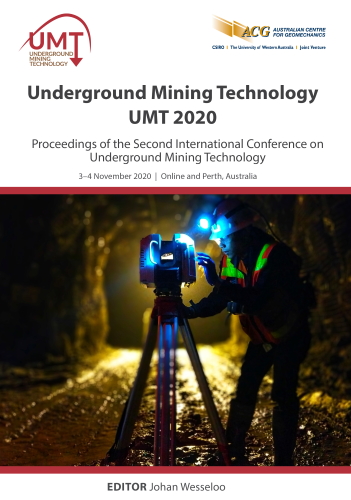Mobile drone LiDAR structural data collection and analysis

|
Authors: Baylis, CNC; Kewe, DR; Jones, EW |
DOI https://doi.org/10.36487/ACG_repo/2035_16
Cite As:
Baylis, CNC, Kewe, DR & Jones, EW 2020, 'Mobile drone LiDAR structural data collection and analysis', in J Wesseloo (ed.), UMT 2020: Proceedings of the Second International Conference on Underground Mining Technology, Australian Centre for Geomechanics, Perth, pp. 325-334, https://doi.org/10.36487/ACG_repo/2035_16
Abstract:
The BHP Olympic Dam underground mine site has experienced ongoing issues with overbreak within its stopes in the recently-developed Southern Mining Area. The rock mass is poorly characterised and there are limited data on key structures influencing the ultimate shape of stopes and the extent of overbreak. The introduction of the Emesent Hovermap mobile drone LiDAR system has provided more extensive, accurate scan coverage of existing stopes, some which were previously inaccessible via earlier scanning methods. This new approach provides a much higher resolution scan than does the industry standard Cavity Monitoring System. With these data, a new methodology of digitally geo-mapping exposed structures within the stopes has been developed to create a new dataset. This is now used for further mine planning through comparing, validating, and appending to modelled geological structural features. This paper discusses the process of acquiring and preparing drone-based LiDAR data for geomechanics and explores the spatial and structural relationship between drone data and window mapping for implementation into Olympic Dam's future stope designs. The back-analysis of stope failures through the LiDAR scan structural mapping has provided a great deal of insight into structural characterisation of underground areas and can assist in planning future stopes. It has not only provided more detailed information on the previously identified large persistent structures but has also identified large multi-stope spanning structures which were previously unrecognised. Evidence of broader zones of weakness, more extensive than previously appreciated, were also uncovered through small-scale structural persistence through mine areas.
Keywords: LiDAR, structure, underground, stope, drone, geo-mapping
References:
Cloudcompare 2020, Cloudcompare, version 2.10.2, computer software, Telecom ParisTech, Paris, http://www.cloudcompare.org/
Deswik 2019, Deswik.CAD, version 2018.3.1188, computer software, Deswik, Brisbane, https://www.deswik.com/product-detail/deswik-cad/
Jones, E, Reardon, D & Hrabar, S 2019, ‘The use of automated drones in underground hard rock mines’, in W Joughin (ed.), Proceedings of the Ninth International Conference on Deep and High Stress Mining, The Southern African Institute of Mining and Metallurgy, Johannesburg, pp. 323–334,
Jones, E, Sofonia, J, Canales, C, Hrabar, S & Kendoul, F 2020, 'Applications for the Hovermap autonomous drone system in underground mining operations', The Journal of the Southern African Institute of Mining and Metallurgy, vol. 120, pp. 1–8.
Roscience 2020, Dips, version 8.002, computer software, Rocscience, Toronto, https://www.rocscience.com/
Vallejos, CAC 2019, Structural recognition and rock mass characterisation in underground mines: A UAV And LiDAR Mapping Based Approach, MSc thesis, Universidad De Concepción, Concepción.
Woolmer, DJ, Jones, E, Taylor, J, Baylis, C & Kewe, D 2021, ‘Use of Drone based Lidar technology at Olympic Dam Mine and initial Technical Applications’, Proceedings of the Underground Operators Conference 2021, Australasian Institute of Mining and Metallurgy, Melbourne, submitted for publication.
© Copyright 2024, Australian Centre for Geomechanics (ACG), The University of Western Australia. All rights reserved.
View copyright/legal information
Please direct any queries or error reports to repository-acg@uwa.edu.au
View copyright/legal information
Please direct any queries or error reports to repository-acg@uwa.edu.au
